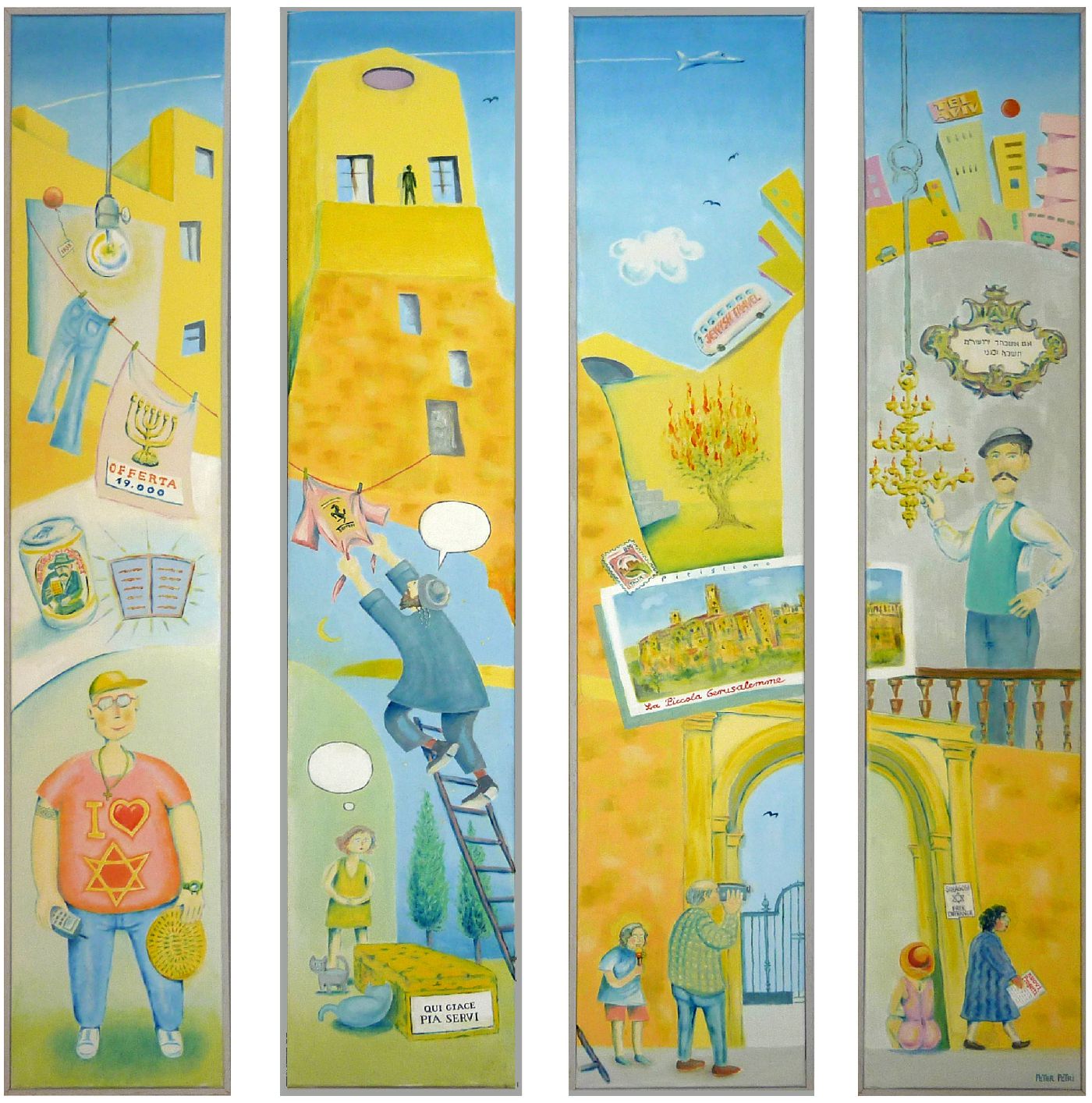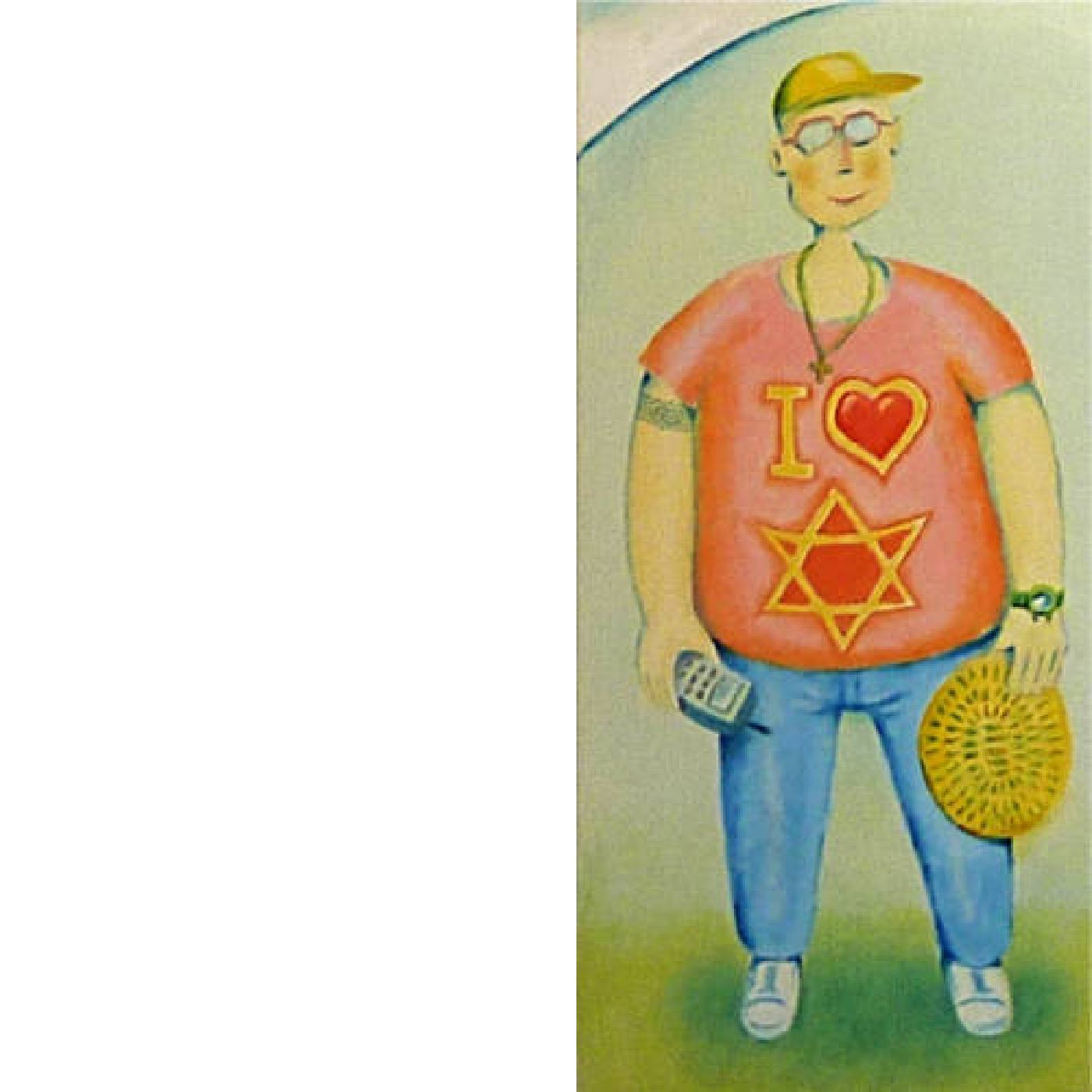


"das Kleine Jerusalem"
"The Little Jerusalem"
"La Piccola Gerusalemme"
Gemälde / painting / quadro
4 pt, 1.50 x 1.50 m
Öl auf Leinwand
oil on canvas
olio su tela
Das kleine Städtchen Pitigliano im Süden der Toskana hatte vor etwa 150 Jahren im Verhältnis zur Gesamteinwohnerzahl mit etwa 20 % aller Einwohner die grösste jüdische Gemeinde von ganz Italien. Es gab eine längere kulturell interessante Periode des Zusammenlebens von Christen und Juden. In dieser Zeit wurde Pitigliano „Das Kleine Jerusalem“ genannt. Diese Situation wurde nicht durch den Holocaust beendet, sondern durch die neuerwor-benen Freiheiten für Juden nach der italienischen Staatsgründung, als ein Grossteil der Juden die Stadt verliess. Heute gibt es keine jüdische Gemeinde mehr, aber das Erbe wird gepflegt und wird zu einem Anziehungspunkt für Touristen.
Das Bild bietet assoziative Zugänge zur jüdischen Geschichte und Gegenwart von Pitigliano.
Pitigliano has been called „The Little Jerusalem“ because 150 years ago it had the biggest Jewish community of whole Italy in relation to the number of its inhabitants.
The picture is about the different kinds of access one can have to the jewish culture of Pitigliano. There is no fixed message, the painting allows to associate various ways concerning the past of Pitigliano's Jewish community as well as it's reflection in our times and into the future, including it's combination with modern marketing concepts.
150 anni fa Pitigliano aveva, relativamente al numero di abitanti, la più grande comunità ebraica di tutta l’Italia, esse costituiva circa il 20 per cento della popolazione. Oggi la comunità non esiste più, ma ciò che ne è rimasto come la sinagoga è oggetto di cura ed attrazione per i turisti.
Il quadro offre accessi associativi alla storia e al presente ebraico di Pitigliano.
"Man sieht den Fundamental-Orthodoxen, dem ein Ferrari-T-Shirt auf der Leine schon zu viel ist, den naiven jungen Kultur-Hopper mit Christenkreuz, Keltentattoo und dem I Love Jews-Motto auf dem Hemd. Darüber eine Dose Moretti-Bier mit dem kernig-konservativen Tiroler Trinker, daneben die 10 Gebote von der Decke der Synagoge. Ein junges Mädchen gedenkt still einer Gleichaltrigen, die schon 100 Jahre tot ist. Den brennenden Dornbusch gibt es auch, hier als Ölbaum. Rechts oben kommt ein Reisebus an mit einer Ladung israelischer Touristen auf der Suche nach ihren europäischen Wurzeln, nicht aus dem grossen Jerusalem, sondern aus Tel Aviv. Unten ist der Eingang zur Synagoge, umlagert von Touristen.
Darüber steht der Lampenanzünder der Synagoge (gemalt nach einem alten Foto), im Hintergrund der hebräische Spruch “Wenn du jemals Jerusalem vergisst, soll dir die rechte Hand abfallen“.
Das Gebäude ganz oben mit dem ovalen Auge ist die wieder aufgebaute Synagoge. Auf einem Sims an ihrer Aussenwand über dem Abgrund regungslos wartend ein Mensch. Man könnte fragen: Wird er springen? Da kann ich beruhigen: wird er nicht!" - Text: Petri
"In this sense contrasts or contradictions are outlined such as between the stupid, but interested tourist boy on the left below with his christian cross, celtic tatoos, mazze-bread and cellular phone, who is proudly wearing his t-shirt, that says: "I Love Jews!". On the other side a memory of the times when the community was still alive, the candle lighter man inside the synagogue, taken from an old photograph.
On the right side you can see a bus heading for the Piccola Gerusalemme just arriving from, no, not from Jerusalem, but Tel Aviv. Maybe a group of Israelian tourists in search of their european roots. But you can also see a very tough fundamental jew, who knows, he is in possess of the pure truth trying to take away a Ferrari t-shirt. On the left panel you see a today's girl on the Jewish cementary just meditating about a girl of her age that died about 100 years ago. On the right below the entrance of the synagogue with more tourists with the invisible centre exactly between two parts of the painting. On top the oval eye of the Synagogue that was nicely restored about 10 years ago with a man outside in a dangerous position, who is just waiting motionlessly. You could ask: will he jump? Calm down: he will not!" - text: Petri
"Si vede l’ ebreo ortodosso fondamentalista, per il quale già una maglietta Ferrari stesa sul filo sarebbe troppo, l’ingénuo giovane di cultura hopper con la sua croce cristiana, il tatuaggio celtico e il motto "I Love Jews" sulla camicia. In alto su una scatola è rappresentato la birra Moretti con il vigoroso conservatore Tirolese che beve, mentre accanto vi sono i 10 comandamenti del soffitto della sinagoga.
Una ragazza giovane tranquillamente si ricorda di una coetanea che è già morta da 100 anni. Il pruno bruciante è qui sostituito da un olivo. Dalla destra arriva un pullman pieno di turisti israeliani alla ricerca delle loro radici Europee. Non sono della grande Gerusalemme, ma di Tel Aviv. Sotto si vede l’ingresso alla sinagoga assediato dai turisti. Qui a destra la Signora Servi scappa con una lista in mano: nuovi progetti.
Più in alto un uomo accende le lampade della sinagoga (questo particolare è ripreso da una vecchia foto di Denci), sul fondo c’è il testo ebraico: "Se mai dimentichi Gerusalemme, la tua mano destra si staccherà“. L’edificio sopra con l’occhio ovale è la sinagoga restaurata. Fuori su un cornicione è fermo un uomo che guarda l’abisso aspettando Ci si potrebbe domandare: salterà? Posso tranquillizzare tutti: non lo farà." - testo: Petri
PARADISO@DIASPORA
Im November / Dezember 2000 veranstaltete in Berlin die Berliner Künstlergruppe "Meshulash" zusammen mit italienischen Künstlern eine Ausstellung zum Thema "Jüdisches Leben in Italien" unter dem Titel "Paradiso@Diaspora". Die Ausstellung fand im Rahmen der jüdischen Kulturtage statt. Einige der Teilnehmer beschäftigten sich bei ihren Beiträgen mit der jüdsichen Geschichte und Kultur von Pitigliano. Peter Petri hat aus seiner nichtjüdischen Perspektive das Bild "La Piccola Gerusalemme" beigesteuert, ein ironisches Spiel mit Motiven aus der jüdischen Geschichte und Gegenwart Pitiglianos.
